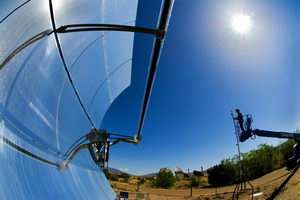New invention to make parabolic trough solar collector systems more energy efficient

A mirror alignment measurement device, invented by Rich Diver, a researcher at Sandia National Laboratories, may soon make one of the most popular solar collector systems, parabolic troughs, more affordable and energy efficient.
Diver's new theoretical overlay photographic (TOP) technology is drawing interest from the solar industry because of its simplicity and the need to find solutions for global warming.
"TOP alignment could cure a significant problem with trough systems -- inaccurate mirror alignment that prevents sunlight from precisely focusing on solar receivers," Diver says. "Improperly aligned mirrors result in lost and wasted energy."

Working with Diver on the project is Tim Moss, who serves as project manager and primary software and hardware developer.
Parabolic troughs use mirrored surfaces curved in a parabolic shape. The mirrors focus sunlight on a receiver tube running the length of the trough. Oil runs through the focal region where it is heated to high temperatures and then goes through a heat exchanger to generate steam. The steam is then used to run a conventional power plant.
The world's largest parabolic trough facilities, located in the Mojave Desert near Barstow, Calif., consist of nine plants producing 354 megawatts of power at peak output. The plants range in size from 14 to 80 MW. The 30 MW plants near Kramer Junction, for example, each have about 10,000 modules with each module comprising 20 mirrors. A 64 MW trough plant, which will supply power to Las Vegas, Nev., is expected to go on line soon. A 1 MW plant also exists in Arizona.
An issue with parabolic trough systems, says Diver, has been lack of accurate mirror alignment that prevents maximum energy efficiency.
Borrowing from variations on methods used to align mirrors in solar dish systems, Diver came up with TOP alignment, an optical approach to rapidly and effectively evaluate the alignment of mirrors in parabolic trough power plants and prescribe corrective actions.
"This method could be used during trough power-plant construction to improve the performance of existing power plants or for routine maintenance," Diver says. "It should be an ideal mirror alignment technique because it is simple to set up, requires a minimum of sophisticated hardware, and does not require removal of the receiver."
The TOP approach consists of a pole with five cameras positioned along it. Four of the cameras take digital photographic images of the four rows of mirrors on the parabolic module. The middle camera photographs the module's center, where a boresight gauge is attached, which is used to vertically center, or "boresight," the pole to the trough module.
Vector algebra and projection theory are then used to predict the theoretical projected image of the receiver for perfectly aligned mirrors. The calculated theoretical image of the receiver for perfectly aligned mirrors is overlaid on the photographs of the actual receiver image position in the mirrors. The images and the actual image are compared to show how the mirrors should be aligned. It then becomes a matter of adjusting the mirrors to the correct alignment.
"This whole process is very simple," Diver says. "Once the mirrors are aligned, the energy savings start. It's like picking money off the ground. And the mirrors are aligned for the life of the plant."
To address the needs of commercial-scale trough power plants such as those at Kramer Junction, Calif., Diver and Moss mounted a TOP fixture on a trailer pulled by a government van that can safely be moved along highways to parabolic power plants. The cameras would photograph the modules at the different plants. The images would be processed later, and work orders detailing alignment adjustment would be created. Alignment adjustments could be made when convenient, even while the plant is operating.
Diver says that people have been trying to come up with ways to align mirrors in parabolic modules for at least 20 years, but their methods have always been "cumbersome and took too long."
He and Moss have developed the TOP technique using a 20-year-old parabolic module located at the Sandia National Solar Thermal Test Facility in Albuquerque. The module is the same as those at Kramer Junction. They did "shakedown" testing of TOP at a trough plant outside Tucson, Ariz., in March and October 2006. The next steps will be to test the system at Kramer Junction later this year and eventually license the technology to parabolic trough power plant operators and/or trough project developers.
Source: Sandia National Laboratories





















